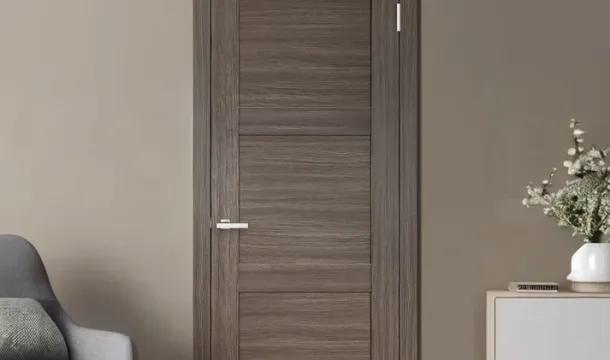Maintaining Proper Interior Door Alignment for Long Lasting Performance
Popular Articles
- Choosing the Perfect Interior Doors for Your Canadian Home
- A Complete Guide to Choosing Interior Doors for Canadian Homes
- The Challenges of Painting Interior Doors
- Understanding Interior Doors and Their Role in Your Home
- The Perfect Blend of Reliability and Design: Interior Doors with Italian "Sandwich" Technology
Adjust hinges regularly to prevent sagging or misplacement that leads to uneven gaps and increased wear. Over time, screws may loosen, causing the panel to shift; tightening them with a screwdriver can restore correct positioning immediately.
Use shims behind hinges when reinstalling doors to achieve precise spacing between the frame and slab, reducing friction and enabling smooth operation. This technique also helps counteract minor imperfections in framing common in older Canadian homes.
Check for warped edges or swelling caused by humidity fluctuations prevalent in many regions of Canada. Addressing these issues early by sanding down affected areas or applying sealants will help maintain seamless closure and reduce strain on hinge mechanisms.
Identifying Door Misalignment Signs
Check for uneven gaps between the frame and the door edge; inconsistent spacing often signals shifting or warped hinges. Doors that drag against the floor or stick at certain points usually indicate sagging caused by loose or damaged hinges.
Listen for creaking noises when opening or closing, which typically arise from hinge wear or misplacement. Another clear sign is difficulty latchingif the lock or latch doesn't engage smoothly, hinge positioning may have shifted, causing misfit.
Visually inspect hinge screws to ensure they remain tight and properly seated; loose fasteners allow the door to tilt. Warped hinges themselves can distort alignment, so swapping out rusty or bent hardware can restore even operation.
Use a level across the door surface: if it tilts forward or backward instead of sitting flush within its frame, realigning or replacing hinges will likely be necessary. Early detection of these symptoms prevents further structural strain and extends functional lifespan.
Adjusting Hinges for Alignment
Begin by tightening all hinge screws, as loose fasteners often cause sagging or uneven gaps. Use a screwdriver to secure each screw firmly into the frame and door edge.
If the panel remains misaligned, slightly loosen the screws on the hinge closest to the gap issue. Insert thin cardboard shims behind this hinge leaf to shift the door incrementally. Test movement after adding each shim until edges align evenly.
For doors rubbing against the frame at the top or bottom, adjust the position of hinges vertically. Remove screws from one hinge leaf, reposition it up or down by a few millimeters, then retighten. This minor vertical shift can eliminate scraping without removing or replacing hinges.
When hinges are old or damaged, replace them with new ones matching original dimensions and screw placements. Using high-quality steel hinges ensures stable support and reduces future alignment problems.
Check that hinge pins move freely; apply a small amount of lubricant if stiffness restricts smooth operation. Freely moving pins help maintain consistent door positioning over time.
After adjustments, open and close the panel multiple times to confirm smooth motion and even spacing along all sides. Fine-tune screws or shims as needed to achieve precise fitment.
Replacing Worn Door Components
Replace damaged hinges immediately to prevent sagging and ensure smooth operation. Select heavy-duty steel hinges with corrosion-resistant finishes for enhanced durability, especially in high-traffic areas. When removing old hinges, check the screw holes; if they're stripped, fill them with wood filler or insert longer screws for a secure fit.
Inspect latch mechanisms and strike plates alongside hinges. Worn latches can cause misalignment and difficulty closing. Upgrade to adjustable strike plates that allow fine-tuning without removing the entire frame, improving seal and function.
Swapping out warped or cracked door edges restores structural integrity. Use moisture-resistant materials if exposure to humidity is a concern. Additionally, replacing hinge pins with stainless steel variants can reduce squeaking and wear over time.
For optimal results, install new components in matched setsmixing old and new hardware may lead to uneven wear and alignment issues. Always confirm that replacement parts meet or exceed original specifications to maintain consistent operation throughout the door's lifespan.
Preventing Sagging Over Time
Regularly lubricate hinges with a lightweight machine oil to reduce friction that accelerates wear and sagging. Avoid heavy grease, which can attract dust and grit, causing faster degradation.
Install longer screws in the hinge platesat least 3 inches longanchoring into the door frame studs rather than just drywall or softwood. This reinforcement dramatically decreases stress on hinge mounts, preventing gradual drooping.
Ensure the door is hung so its weight is evenly distributed across all hinges. For taller or heavier doors, adding a third hinge positioned equidistant between the top and bottom ones helps support load and minimize bending over time.
Use weather-stripping materials that do not create excessive resistance when opening or closing. High friction from tight seals can pull on hinges repeatedly, accelerating sag.
Routine Inspection Checklist
- Check for loose hinge screws every six months; tighten as needed to maintain firm attachment.
- Look for slight gaps between the door edge and frame at hinge locations indicating initial sag.
- Listen for creaking noises during operationoften a sign of hinge fatigue requiring attention.
- Assess paint cracking near hinges, which may reveal movement stress impacting door stability.
Additional Preventative Measures
- Replace standard steel screws with rust-resistant options such as stainless steel or brass to avoid corrosion weakening fasteners over time.
- Add reinforcing metal plates behind hinges if mounting surfaces show signs of crumbling or splitting wood.
- Avoid hanging additional objects like wreaths directly on the door surface above hinges to prevent uneven weight distribution.
Regular Cleaning and Lubrication
Clean hinges quarterly using a soft cloth dampened with mild detergent to remove dust, dirt, and debris that accumulate and hinder smooth operation. Avoid harsh chemicals that can corrode metal surfaces.
After cleaning, apply a lightweight silicone-based lubricant or a graphite powder specifically designed for metal joints. These reduce friction without attracting dust buildup like oil-based lubricants might.
Focus lubrication on the hinge pins and knuckles; lift the door slightly if possible to access these areas fully. Excess lubricant should be wiped away to prevent dripping onto flooring or surrounding trim.
Inspect hinges for signs of rust or stiff movement during this process. Address any corrosion promptly with fine steel wool followed by protective coating to extend hardware lifespan.
Consistent cleaning and lubrication minimize wear and help maintain smooth swinging action, reducing the risk of sagging or uneven closure over time.
Popular Articles
- Choosing the Perfect Interior Doors for Your Canadian Home
- A Complete Guide to Choosing Interior Doors for Canadian Homes
- The Challenges of Painting Interior Doors
- Understanding Interior Doors and Their Role in Your Home
- The Perfect Blend of Reliability and Design: Interior Doors with Italian "Sandwich" Technology

Choosing the Perfect Interior Doors for Your Canadian Home

A Complete Guide to Choosing Interior Doors for Canadian Homes
